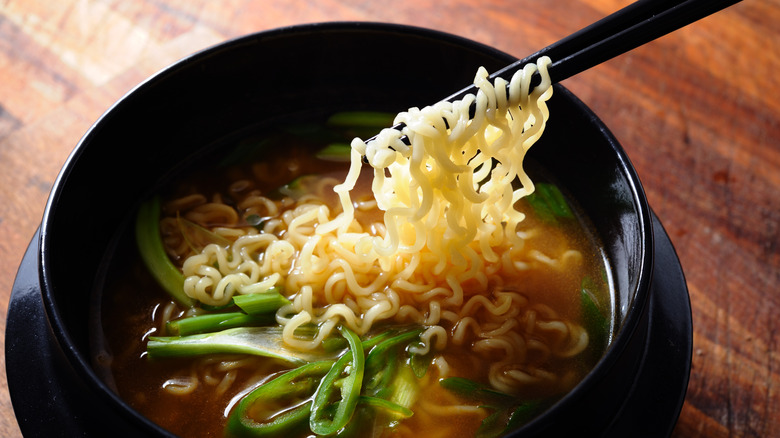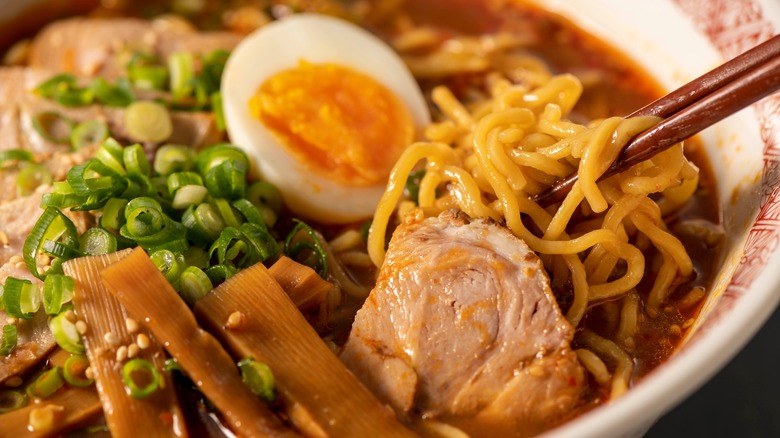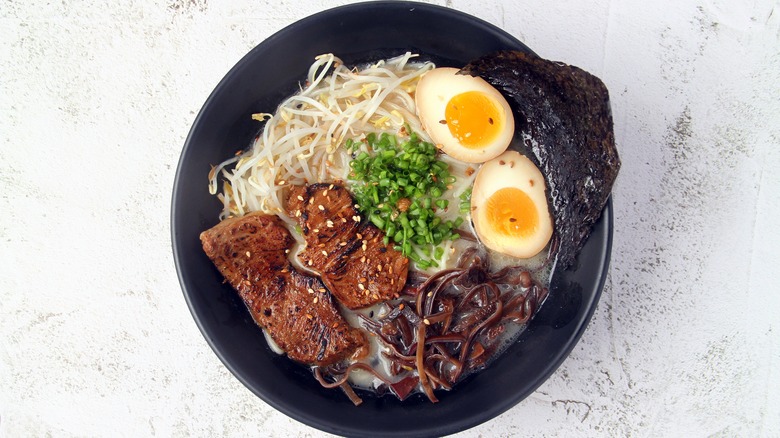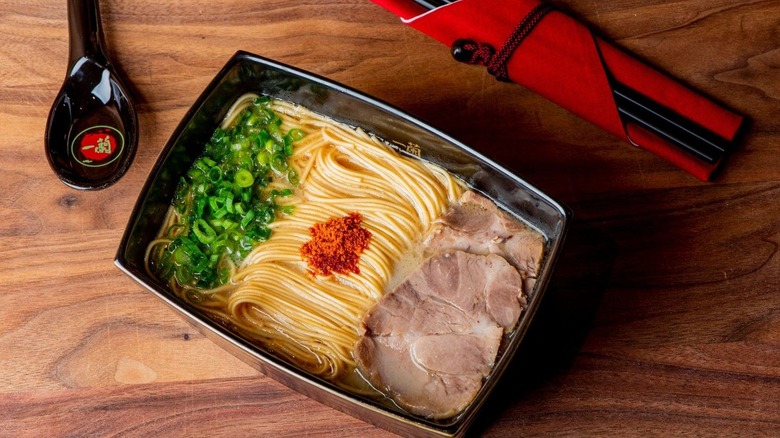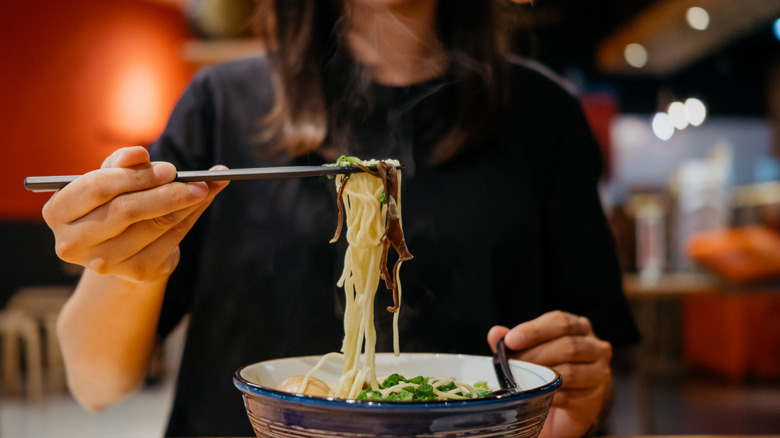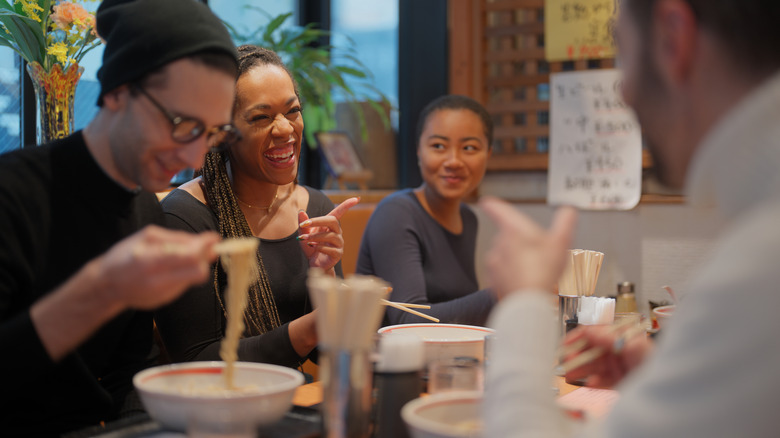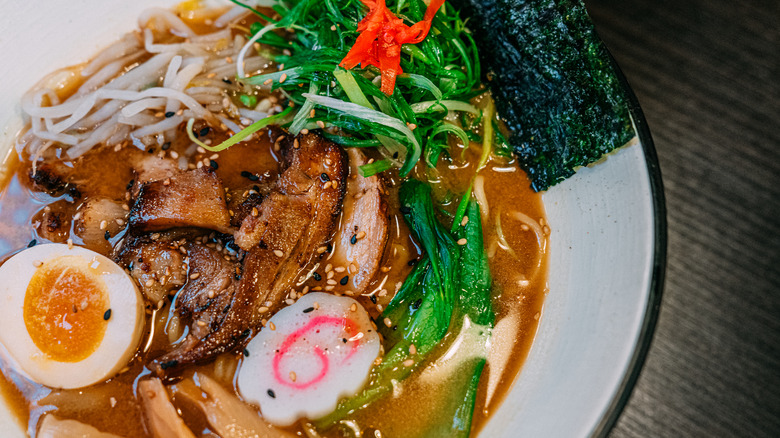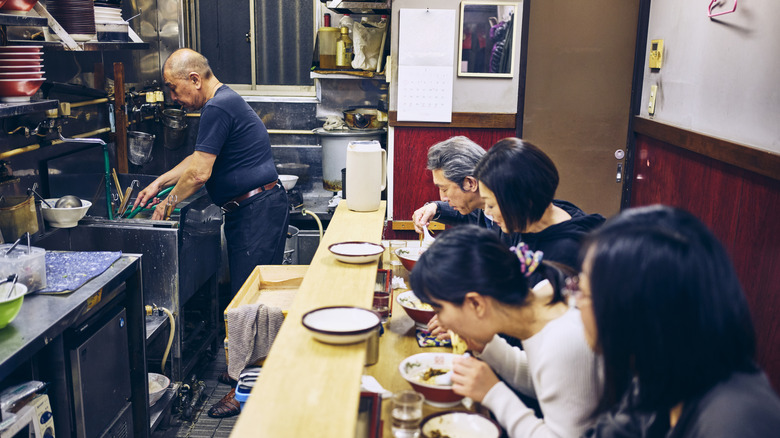12 Common Mistakes To Avoid When Ordering Ramen At A Restaurant, According To An Expert
Whether you've never tried restaurant ramen before or are perfectly familiar with all your favorite ramen menu items, there might still be a few mistakes you're making when it comes to ordering ramen at a restaurant. For all the best ordering tips, I wanted to talk to a ramen restaurant expert to get a better sense of what every customer should know when they're going out to eat ramen.
I spoke to Annie Chen at ICHIRAN, Japan's number one ramen brand and famous global chain of ramen restaurants. It's no secret that ICHIRAN serves top-quality ramen all around the world (and you might also recognize it as the introvert's dream ramen restaurant), so it was the first place I wanted to ask about the most common mistakes customers make when ordering ramen. Chen gave me a few expert tips straight from ICHIRAN so you can perfect your ramen-ordering experience the next time you stop by your local ramen shop — or want to visit ICHIRAN's three New York locations.
Not eating your ramen right away
One of the biggest ramen mistakes that Chen sees frequently is that some customers don't start eating their ramen as soon as it arrives at the table. "Ramen is served right at the peak of its flavors," Chen says. "When you wait, the noodles absorb the broth and get soggier, losing their original texture and flavor." Although anyone who's familiar with traditional ramen may already know that some ramen broths take several days to prepare, the noodles themselves are always cooked to order. This means that, as soon as your bowl of ramen is assembled, the clock is ticking on how long you have to enjoy it fresh.
"Ramen is quite literally fast food," adds Chen. "Chefs make it quickly once you order, and you will see most people in Japan slurp their entire bowl in just a few minutes." Ramen wasn't originally designed to be eaten over a long, sit-down meal. So no matter how good the conversation at your table is, you should never wait to start eating your ramen.
Not taking advantage of substitutions
When it comes to ramen, is it better to substitute toppings or leave them as-is? Chen's take is that it isn't necessarily a bad thing to ask to sub out ramen toppings you don't like. "Ramen is so versatile, most toppings will work well with it," she says. "Like choosing what you want in your sandwich, it really is up to your personal preferences." Some ramen restaurants will even offer completely customizable dishes so you can experiment with creating your own ideal bowl of ramen.
If you've tried the ramen bowl you're ordering before and want to leave off a topping or two, there's no harm in doing so. You may also notice that some ramen restaurant menus offer special customizations to all of their dishes, often offering a side menu of toppings that cost a small amount of extra money to add to a dish. Some menu items may even come with recommended additional toppings, so if you want to add or substitute something, you'll know exactly what works well with the dish.
Chen does note that not all ramen restaurants will offer substitutions. However, ramen restaurants should (almost) always be able to leave out toppings you don't want on your dish. When in doubt, ask — but don't be afraid to opt out of a texture or flavor you're just not a fan of.
Not understanding your ramen broths
There are different types of ramen dishes that will give you an entirely different experience based on which one you order. You might think that the difference in different ramen dishes lies mostly in the toppings, but you'd be mistaken. The four main types of ramen dishes are shio (salty ramen), shoyu (soy sauce ramen), tonkotsu (pork ramen), and miso (usually a yellow miso broth ramen).
"Shio and shoyu ramen are lighter broths, but they can also be packed full of flavor," says Chen. "I recommend these types of ramen to people who enjoy flavorful, but not fatty ramen." Tonkotsu ramen, on the other hand, is a much richer, creamier pork broth. On milk-based broths, Chen adds, "They are great for people who enjoy a soft, creamy texture."
Miso will often be used for vegetarian ramen. It's a salty, umami broth that is somewhat similar to shio ramen. It falls into the category of being a lighter ramen broth. There's more than one kind of miso; white miso has the lightest flavor, yellow is most commonly used for ramen, and red is richer and saltier.
Not swapping out your ramen noodles
If you didn't find the last bowl of ramen you ate to be satisfactory, you might be missing a key consideration when it comes to ordering ramen: the ramen noodles. Although many people picture ramen noodles as the kind that comes with instant ramen — very curly, thin, and short noodles — there are many different types of ramen noodles, all of which can vary widely. Thickness, texture, and sometimes noodle ingredients (such as rice versus wheat) can change everything about a ramen dish.
"Do you like noodles that are thin and easy to slurp?" Chen asks. "Or do you prefer more texture, like the curly noodles? Most ramen noodles are made with the same basic ingredients, but the thickness and shape of the noodles can enhance or detract from your ramen experience." The ramen noodle is partly a vessel for holding the broth and also a main element of texture for the dish. If you find the texture of a certain kind of ramen noodle unappealing, there's no doubt it will ruin the entire dish for you.
Most ramen restaurants will come with a standard noodle that they use for their dishes. But many ramen menus will also offer the option of swapping out your noodles based on their texture. If you have a specific preference in mind, you should ask about trying a different kind of noodle.
Not knowing table condiments
When it comes to sit-down ramen restaurants, you may notice a few condiment bottles on your table. You'll most typically notice these when the ramen restaurant you're at has other non-ramen menu options available (notably items like dumplings or potstickers). The three most common condiment bottles you'll see at a ramen restaurant are soy sauce, rice vinegar, and chili oil. Together, these three sauces can be mixed together to create a dip for your dumplings.
Unlike other restaurant condiments you may be familiar with, these condiments aren't typically meant for you to put on your ramen. The bowl you order already comes with an extremely flavorful broth, so adding other condiments on top would make it too overpowering. With that being said, chili oil is the exception to this; it's a relatively common ramen addition if you prefer a super-spicy ramen dish.
Depending on the restaurant you're at, your table may come with other ramen topping options you can add to your ramen as you please. This is a little less common in the U.S., but if you're presented with toppings you're not familiar with, just ask your server what they are and how they're intended to be used. The restaurant may also be able to help you with recommendations for what kinds of table toppings you should add to a particular ramen dish.
Not planning ahead for allergies
Anyone with common allergies or dietary restrictions probably already knows to check restaurant menus ahead of time. With ramen restaurants, some allergens should have relatively easy ramen alternatives — for example, if you're gluten-free, many ramen noodles are available as rice noodles instead of wheat. For dietary restrictions, ramen dishes like vegetarian ramen are becoming more popular on ramen menus, leaving you with fewer customizations to worry about.
Regardless, Chen recommends checking with the restaurant to ensure your dish will be free of any ingredients you're concerned about. "Chefs often use unexpected ingredients in their broth, so contact the restaurant directly with any specific allergy questions," Chen notes. Chen also warns that, even if you're not seeing any problems with the menu, you may want to inform the chef regardless.
As with many menus, you may also find that ramen menus have specific guides as to what dishes contain certain allergens. You should also know that ramen restaurants may not always be able to offer alternative menu items for every allergen. If you're at a ramen restaurant that offers other menu items besides ramen (such as appetizers, rice dishes, and sides), you may be more likely to find an allergen-free dish.
Not planning ahead for allergens -- in Japan
Standard ramen etiquette mostly doesn't change when you're eating ramen in the U.S. versus Japan — the same rules will apply to everything from the ramen you order to the way you rest your chopsticks. But allergens can be a little bit different, and those worried about dietary restrictions will need to do a little more prep work. Chen points this out specifically as an important note for those hoping to order traditional ramen abroad.
"There are slight differences in what is categorized as common food allergens in Japan and America," Chen says. This doesn't mean that Japanese brands don't warn customers about potential allergens — but the list of what qualifies as an allergen changes a little. Chen says that the seven allergens required to be labeled in Japan are: buckwheat, crab, egg, milk, peanuts, shrimp, and wheat. "If you have allergies that are not part of Japan's seven major food allergens, I recommend you translate what you are allergic to into Japanese. Save the Japanese word on your phone... and show it to the restaurant when asking about food allergens."
Not knowing your go-to preferences
There's certainly nothing wrong with trying every bowl of ramen on the menu — after all, ramen is made to be experimented with. But if you're looking for your next go-to order, you don't have to go through every single bowl to find something you'll definitely be satisfied with. Chen recommends a useful system for figuring out what kind of ramen you want to enjoy.
It's important to keep the different kinds of ramen — shio (salt), shoyu (soy sauce), tonkotsu (creamy pork), and miso (umami) — in mind as a way of figuring out what flavor profile you'll find in a certain bowl of ramen. Then, Chen recommends considering the last bowl of ramen you liked to figure out what you should try next. "If you were left wanting more flavor, go for meat-based ramen broths with more fat (sometimes you can choose how fatty you want the broth to be)," she says. "Or if you thought your last ramen was too strong, go for a lighter broth that is less creamy and has little fat."
If you've never had a bowl of ramen before, Chen adds that you can even use your soup or pasta preferences to figure out which kinds of ramen you might enjoy. If you prefer soups with strong flavors or rich broths, then a meat ramen broth might be your best bet. For those who love rich, creamy pastas, tonkotsu ramen could be your next favorite meal.
Not using ramen utensils properly
If you're unfamiliar with ramen, you may not know how to eat it properly when you're out at a restaurant. Ramen restaurants will provide you with two different utensils: chopsticks and a ramen spoon. The spoon will be very wide, deep, and usually ceramic.
To eat a proper bite of ramen, first take the ramen spoon in your non-dominant hand, grabbing the chopsticks in your dominant hand. You can use the chopsticks to grab a small portion of noodles out of the bowl and slurp the noodles directly from the chopsticks. Use the ramen spoon to ladle broth out of the bowl and drink it — when drinking broth from the spoon, drink from the side! You can also use the spoon to hold a combination of noodles, broth, and toppings. Typically, when you're eating ramen noodles, you should always be holding one end of the noodles with your chopsticks rather than leaving them entirely in the spoon — this allows them to be slurped up rather than eaten in a single bite. It's also perfectly acceptable to drink the broth from the ramen bowl if you'd like.
Not following restaurant etiquette
A central part of eating ramen at a restaurant is understanding chopstick etiquette, and there are certain behaviors you'll want to avoid when using chopsticks at a ramen restaurant. Chen has a few pieces of etiquette advice for beginner chopstick users. If you are eating ramen with chopsticks, one major piece of etiquette is to never leave your chopsticks standing straight up in your bowl. You might think that sticking your chopsticks into your dish is a good way to set them down for a second, but don't do it. This actually symbolizes death in many cultures. If you need to set your chopsticks down, set them to the side on a chopstick rest. If you're not finding one nearby, you can use a plate or napkin edge to rest the tips of the chopsticks on. Note that it's also considered impolite to rest your chopsticks across the edges of your bowl, so you should keep your chopsticks off your ramen dish when you're not using them.
If you're planning on sharing some of your dishes with the table, never pass your food directly from your chopsticks to someone else's — this is another action that is symbolic of death. "Instead, place the food you want to share directly into the other person's bowl," recommends Chen. She also adds another etiquette tip — as with any utensil, you should never wave or point with your chopsticks.
Not asking for a utensil swap
What happens when you're not able to use chopsticks at a ramen restaurant? Is it acceptable to ask for a fork instead? The answer is yes, and it would actually be a mistake not to ask.
Although it's more common to eat ramen with chopsticks and a ramen spoon, it's perfectly fine to ask a restaurant for a fork to use in lieu of chopsticks. You'll still be able to use the ramen spoon to scoop up broth and toppings, but every ramen restaurant should carry forks for you to use if you prefer. If you're worried about ramen etiquette, there's no need to be — restaurants will be perfectly understanding. The most important part is that you're able to actually eat (and enjoy) your ramen; especially since the dish is designed to be eaten relatively quickly, it's wise for you to request whichever utensil is easiest for you to eat with.
Ramen noodles are typically designed to be slurped. If you're looking for the full ramen experience, you might want to try picking up the noodles with your fork instead of twirling noodles around it. This will ensure you're able to eat ramen the way it was intended to be eaten without needing to use chopsticks.
Not understanding ramen restaurants
When you're planning on sitting down to eat at a ramen restaurant, you should make sure the place you're ordering from is actually expecting customers to stick around for a while. Ramen, as Chen mentions, is traditionally a fast food. In Japan, you frequently see small shops with very little seating (sometimes only at the counter). This is because traditional ramen is typically designed to be eaten in under 10 minutes — you would eat quickly and leave. This allows customers to rotate out quickly without the shop requiring to host a large number of customers at once. Plus, ramen shops with counter service only need to have a chef or two in the back who can hand each dish directly to the customer who ordered it, cutting down on the amount of staff needed for a small shop to run efficiently.
In the U.S., sit-down ramen restaurants are more common. But if you're planning on going out to eat with a large group of friends, you should check ahead to see what type of restaurant you're headed to. Many shops with limited seating won't be able to sit even in small groups together, whereas other ramen restaurants will expect you to stick around for an hour or two as opposed to a few minutes.




